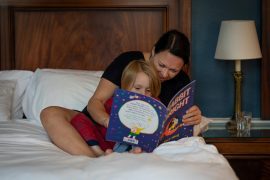So if we know all of this, then what are we asking a six-month-old baby to do when left in a room by themselves?
We know that they do not know that we are coming back… It seems that this so-called very important skill to be taught, is teaching them to stop signalling which is a very important need – to know that their parent/caregiver is close. We are basically asking them to stop communicating because no one is coming/no one is going to respond to their need with a snuggle or a hug. We are waiting for the brain to kick in and shut the baby down.
If we cannot teach a baby to self-soothe, then what can we support a baby to do?
We can support them to self-settle/down regulate. Self-settling is used to describe a baby or child’s ability to “calm down”. The idea is that the baby will learn to settle themselves and be able to control their sympathetic nervous system. Newborns can self-regulate when they are already in a calm state of homeostasis. They can adjust their body temperature, change their breathing, suck on their own hands, bring themselves midline and physiologically settle themselves.
This is one of the many reasons that I DO NOT promote the use of extinction [sleep training]. We know that what extinction is asking babies to do is to stop signalling, not to soothe themselves. When working with toddlers I also don’t expect them to be able to calm on their own during the day or at night. It is important to note that children can begin to learn to self-regulate but this doesn’t even begin until the age of three years old and even then, needs to be supported and taught. After all, how many adults do you know who still struggle with self-regulation?
Thank you for listening to my little rant. Rant done.
REFERENCES:
Bebo Mia, 2017. Infant Sleep Educator Course. Toronto, ON. Retrieved from: www.bebomia.com
Cassels, T. 2016. ‘It’s just a Little Cortisol’: Why Rises in Cortisol Matter in Infant Development. Retrieved from: http://evolutionaryparenting.com/its-just-a-little-cortisol-why-rises-in-cortisol-matter-to-infant-development/
Crenshaw, J. T. (2014). Healthy Birth Practice #6: Keep Mother and Baby Together- It’s Best for Mother, Baby, and Breastfeeding. The Journal of Perinatal Education, 23(4), 211-217. http://doi.org/10.1891/1058-1243.23.4.211
Cubero J, Valero V, Sánchez J, Rivero M, Parvez H, Rodríguez AB, Barriga C. 2005. The circadian rhythm of tryptophan in breast milk affects the rhythms of 6-sulfa-oxy melatonin and sleep in newborn.
Cubero J, Narciso D, Terrón P, Rial R, Esteban S, Rivero M, Parvez H, Rodríguez AB, Barriga C. 2007. Chrononutrition applied to formula milks to consolidate infants’ sleep/wake cycle. Neuro Endocrinol Lett. 28(4):360- 6. – See more at: http://www.parentingscience.com/infant-sleep-aid.html#sthash.tdT598mr.dpuf
Palmer, L. 2009. The Baby Bond. Naperville, Illinois: sourcebooks, Inc.
Shanker, S. 2017. Transcripts for Foundations 1. The MEHRIT Centre. Peterborough, ON.
Whittingham, K., & Douglas, P. 2014. Optimizing Parent-Infant Sleep from Birth to 6 Months: A New Paradigm. Possums Clinic. Queensland, Australia. Retrieved from:www.possumsonline.com
Originally published HERE.
Lauren Heffernan, founder of Isla-Grace, is a certified sleep and well-being specialist and certified sleep educator. After giving birth to her first daughter, Grace, Lauren learned the many challenges of navigating motherhood. These included the multitude of books, information, and people with strong opinions on the right way to be a mother. She quickly learned that the best parent to her child was herself and that in trusting her instincts, she would never go wrong. With this belief, and after certification with the International Maternity and Parenting Institute’s Maternity and Child Sleep Consulting Program, Bebo Mia’s Infant Sleep Educator Program and Mohawk College’s Breastfeeding Program, Lauren launched Isla-Grace and co-created the Baby-Led Sleep Approach. She provides information and support to women at different stages of motherhood and walks each one through the personal journey to become a more confident mother.











What does supporting them to self-settle look like?